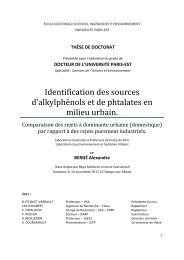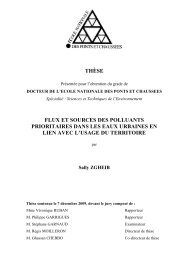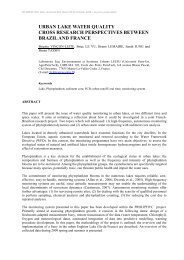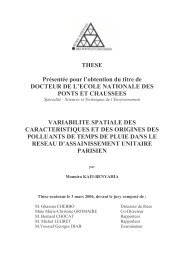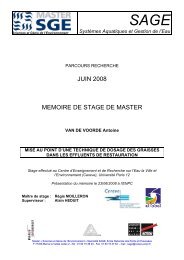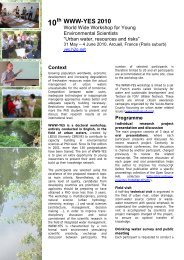View - ResearchGate
View - ResearchGate
View - ResearchGate
You also want an ePaper? Increase the reach of your titles
YUMPU automatically turns print PDFs into web optimized ePapers that Google loves.
Even if the Oslo II text provides that "The Israeli side shall transfer to the Palestinian side, andthe Palestinian side shall assume, powers and responsibilities in the sphere of water and sewagein the West Bank related solely to Palestinian" 3 , several sub-articles limit the PalestinianAuthority's action within its territories. For instance, the transfer of powers only concerns thePalestinians themselves, not the Israelis living in the colonies of the West Bank. Also, thetransfer does not apply to the issues of ownership of water and of sewage in the West Bank (subarticle5), for which arrangements shall be laid down only within the framework of the finalnegotiations (sub-article 4).The institutions related to the Joint Water Committee (JWC), which is in charge of coordinatingthe common action of Israelis and Palestinians in matters of water resource management, aresubject to other constraints. Notably, their role is to "deal with all water and sewage relatedissues in the West Bank" (sub-article 12), i.e. to manage the aspects excluded from thePalestinian Authority's competence by sub-article 5 and to settle any disagreements in thatregard. Since the JWC is composed of an equal number of representatives from both parties anddecisions can only be made by consensus, Palestinians' leeway for their action in the West Bankis again severely limited.For instance, any Palestinian initiative relating to water management (licensing, drilling,increasing extraction) can be blocked by the simple opposition of the Israeli members pursuant tothe committee's voting mechanism, even when the contemplated projects concern areaspopulated mainly by Palestinians, notably the Ramallah and Nablus urban areas. This "right ofveto" also applies to decisions relating to proper Palestinian resources such as the Eastern basinof the Mountain Aquifer. Such failings become especially blatant when compared with the lackof any similar voting mechanism for the prevention of Israeli action regarding the exploitation oftransboundary water resources such as the Western basin.Yet some of the provisions of the Oslo II Agreement seemed to constitute a real advance towardsthe recognition of Palestinians' right to water. For instance, article 40 § I provides that "Israelrecognizes the Palestinian water rights in the West Bank". However, these rights are notspecified in the text, which simply announces that they will be taken into consideration in thefinal status negotiations. Worse, by stipulating that "both sides agree" to maintain "existingquantities of utilization from the resources" (sub-article 3 § IV), the text amounts to thelegalisation of the existing situation resulting from the military occupation, which ischaracterised by the unfair use of water resources to the advantage of Israel, especially those ofthe Mountain Aquifer 4 .Another important shortcoming of the Oslo II Agreement is the lack of precision as regards theprecautionary principle to be applied to the exploitation, management, and utilisation of waterresources. Although article 40 § 3a recalls that both parties undertake to prevent the deteriorationof water quality and take "all necessary measures to prevent any harm to water resources,including those utilized by the other side", this principle only takes the protection of the resourceitself, not of the other party's rights, into account.Lastly, the Oslo II Agreement emphasises that the water quantities allotted to Israeli militarysites and colonies, both for household and agricultural usage, should be maintained.The problems resulting from these legal shortcomings and the accompanying lack of anyPalestinian territorial sovereignty are preventing the coherent management of all water resourcesin the occupied Territories.Therefore, in the case of the Palestinian Territories, where the exercise of the Palestinian nationalterritorial sovereignty is linked to the development of the peace process, the legal andadministrative shortcomings arising from bilateral agreements are preventing the globalmanagement of all water resources. This was the ambiguous background for the passing of thePalestinian Act No. 3 on 17 July 2002. Its purpose is to increase the capacity of the PalestinianTerritories' water resources and to improve their protection against pollution and overexploitationrisks. To that end, the Palestinian Territories' water resources are declared to be apublic good and their utilisation and exploitation is from now on restricted. Any new extractionfor commercial purposes must be authorised first.Given the limited autonomy which, for the aforementioned reasons, Palestinians have inapplying their water policy, this is in many cases a purely theoretical act. Therefore, it is notsurprising that it should concern itself less with the water resources themselves than with theinstitutions charged with managing them, such as the National Water Council and the PalestinianWater Authority, author of the other two previous texts drawn up following the Oslo Agreements(Palestinian National Water Policy, 1995, and Water Resources Management Strategy, 1998).During the French mandate, two texts (stemming, as with the Mejelle, from the preindependencelegal systems) were added to the Lebanese and Syrian legislations relating to watermanagement. These two texts, Order No. 144/S of the High-Commissioner of 10 June 1925 andOrder No. 320 of 26 May 1926, give a definition of the public domain and provide for theprotection and utilisation of water within this same domain 5 . These texts, which constituted thefoundation for both countries' water legislations but were not exhaustive, were completed in2005 in Syria with the Act No. 31 of 16 November relating to water, whose article 2 providesthat watercourses, lakes, waterfalls, springs, and groundwaters are deemed to be a public good.2- Regulation of the use of water resourcesAlthough the development of the national legislations of Middle Eastern countries has led towater being branded a public good, when it comes to its management, it is necessary todifferentiate between surface water and groundwater. Where surface waters (naturalwatercourses, canals, lakes, etc.) seem to be indissociable from the public domain, groundwaters,which are often exploited from private property (wells, drillings, etc.), may on the contrary evadecontrol by the public authorities. In order to counter the resulting threat to this vulnerable, andfor the region’s big cities, essential resource, the respective countries’ national legislationsprovide for a number of specific mechanisms intended to protect groundwaters from pollutionand overexploitation. However, such mechanisms are the exception in national legislationswhich still only rarely differentiate between surface waters and groundwaters (Burchi 1999,Caponera 1992).3 Annex III, article 40, § 4 of Oslo II.a) Protection against pollution4 For instance, in the 1990s, an Israeli used up approximately four times more water from the Mountain Aquifer thana Palestinian (440 to 550 mcm/year for an Israeli and 116 to 121 mcm/year for a Palestinian). According to Nasser,Y., (2003), "Palestinian water needs and rights in the context of past and future development", in: Water in PalestineProblems-Politics- Prospects, Jerusalem, PASIS, pp .85-123.5 Lebanese Republic, Official Journal no. 1998 (supplement)WWW-YES 2008, Paris 13 – 16 May 2008 7WWW-YES 2008, Paris 13 – 16 May 2008 8



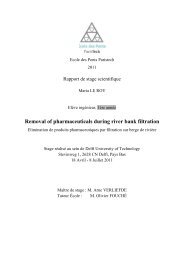
![[pastel-00730831, v1] Incidence des pratiques d'entretien ... - LEESU](https://img.yumpu.com/50938896/1/184x260/pastel-00730831-v1-incidence-des-pratiques-dentretien-leesu.jpg?quality=85)

